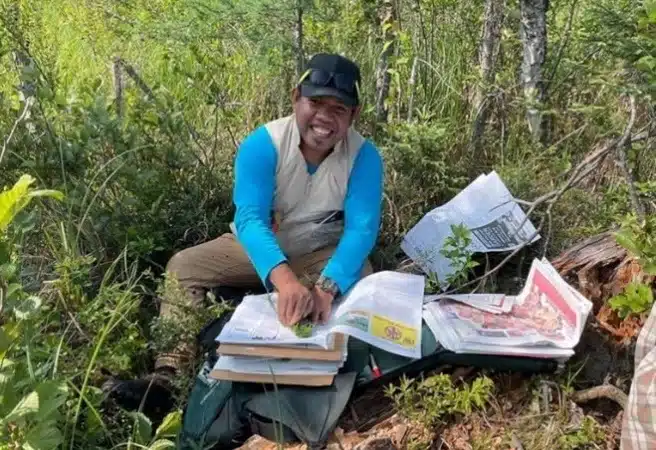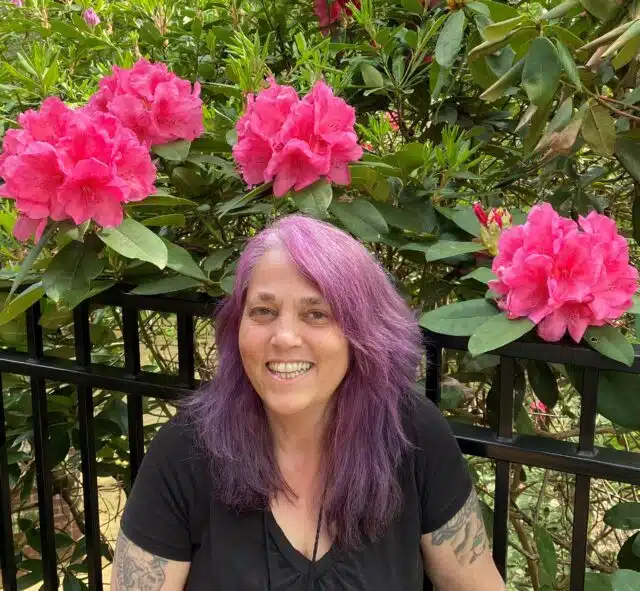Research intern funded by the National Science Foundation joins the team
February 2, 2024

The research department at Holden recently welcomed Yasper Michael Mambrasar, M.S., who will be conducting a one-year research internship at Holden Forests & Gardens funded by the National Science Foundation. Mambrasar is plant systematist with extensive field experience working at the Herbarium Bogoriense in Indonesia. His research in Indonesia focuses on a group of tropical Rhododendron species known as Vireyas, which are found only in the Malesia region. During his master’s studies at University of Wisconsin-Madison, Mambrasar identified and described four new species of Vireya Rhododendron from Tambrauw, Southwest Papua, Indonesia.
Now, as an intern, he will be conducting research on Juniperus virginiana, commonly known as eastern red cedar, under supervision of Dr. Juliana Medeiros.

Eastern red cedar’s expanding range
Eastern red cedar is a coniferous plant native to Eastern North America, ranging from Maine to Florida and extending westward to South Dakota and Texas. Within this native range, eastern red cedar provides important habitat and food resources for birds and other wildlife, especially during the winter when other plants are dormant. Eastern red cedar is also a popular ornamental plant, known for its ease of care and pleasing form. Plus, this species has been used extensively as a traditional medicine wherever it grows, with archeological evidence of its use going back over 6,000 years, demonstrating the high importance of this plant for people.
Recently, this species has been expanding its range into the grasslands of the Midwest and Western U.S., where it can outcompete native grasses, reducing the biodiversity of grassland ecosystems and damaging rangelands that are important for cattle production. This ability to expand its range makes it a model for studying the dispersion of range-expanding native species, and how they can impact both biological systems and human livelihoods.
Mambrasar joins an interdisciplinary team of researchers on the project, with expertise in plant physiological ecology, population ecology, population genetics, seed dispersal, and modeling, all working together to tease apart the factors driving this range expansion. For his part of the project, Mambrasar will investigate the anatomy of eastern red cedar leaves and wood, including plant vasculature.
Plant anatomy and climate tolerance
Plant vascular systems deliver water and nutrients to all the cells in the plant, similarly to how your vascular system delivers oxygen to your cells. Anatomy of the plant vascular system can be one factor determining plant climate tolerance, and Mambrasar’s research will discern the environmental conditions that cause leaves and wood of this species to be damaged.
This work will elucidate the climate conditions favorable for fast growth of this species and help determine where it might be commonly found in the future as climate change alters environmental conditions. As a field biologist, Mambrasar is looking forward to expanding his research tool kit to include new laboratory skills, which can complement his field work in the future.
Botanist in training
In addition to training in lab-based research, Mambrasar is also receiving career counseling as part of his internship. Developing his communication, teaching, and collaboration skills represents a key step in reaching the next phase in his career goal, which is to obtain a Ph.D. in Botany. While at Holden Forests & Gardens, Mambrasar plans to teach a course in field botany and herbarium specimen collection, as well as make presentations of his research to advance his skills in teaching and communication.
Mambrasar also holds a strong interest in learning about botanical gardens themselves while at HF&G, about how they are run, how the guest experience is integrated into the research and conservation objectives, and how gardens are funded, with the idea of developing similar resources in the future to support public engagement and botanical research in Indonesia. As part of this, Mambrasar will also work with Dr. Medeiros to develop collaborations on Rhododendron, which has been a special area of interest for HF&G research and collections going back over 60 years. Mambrasar’s expertise in the tropical Vireya Rhododendron will be pivotal to expanding current studies at HF&G on Rhododendron adaptations to climate, including submission of future National Science Foundation grant proposals to fund research collaborations between HF&G scientists and researchers at Herbarium Bogoriense in Indonesia.
Ultimately, Yasper’s internship is expected to be a jumping off point for him, a place to hone his scientific ideas and the skills that he will need to advance his research career. Thus, international collaborations and National Science Foundation funding to Holden Forests & Gardens support our cutting-edge research, but also support people, speaking to the heart of HF&G’s mission: To connect people with the wonder, beauty, and value of trees and plants, to inspire action for healthy communities.

Juliana S. Medeiros, PhD
Plant Biologist
My research focuses on plant anatomical and physiological acclimation and adaptations to the abiotic environment. I am interested in how phenotypic and genetic variation in plant form and function interact with variation in climate over space and time to drive ecological patterns and the evolution of plant diversity. I focus primarily on plant hydraulic traits, including xylem water transport, leaf gas exchange and the integration of leaf and xylem function.













